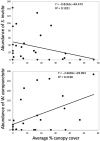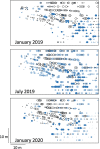The assembly and importance of a novel ecosystem: The ant community of coffee farms in Puerto Rico
- PMID: 33304482
- PMCID: PMC7713940
- DOI: 10.1002/ece3.6785
The assembly and importance of a novel ecosystem: The ant community of coffee farms in Puerto Rico
Abstract
Agricultural ecosystems are by their very nature novel and by definition the more general biodiversity associated with them must likewise constitute a novel community. Here, we examine the community of arboreally foraging ants in the coffee agroecosystem of Puerto Rico. We surveyed 20 coffee plants in 25 farms three times in a period of one year. We also conducted a more spatially explicit sampling in two of the farms and conducted a species interaction study between the two most abundant species, Wasmannia auropunctata and Solenopsis invicta, in the laboratory. We find that the majority of the most common species are well-known invasive ants and that there is a highly variable pattern of dominance that varies considerably over the main coffee producing region of Puerto Rico, suggesting an unusual modality of community structure. The distribution pattern of the two most common species, W. auropunctata and S. invicta, suggests strong competitive exclusion. However, they also have opposite relationships with the percent of shade cover, with W. auropunctata showing a positive relationship with shade, while S. invicta has a negative relationship. The spatial distribution of these two dominant species in the two more intensively studied farms suggests that young colonies of S. invicta can displace W. auropunctata. Laboratory experiments confirm this. In addition to the elaboration of the nature and extent of this novel ant community, we speculate on the possibilities of its active inclusion as part of a biological control system dealing with several coffee pests, including one of the ants itself, W. auropunctata.
Keywords: Solenopsis invicta; Wasmannia auropunctata; biological control; coexistence; community structure; dominance; invasive species.
© 2020 The Authors. Ecology and Evolution published by John Wiley & Sons Ltd.
Conflict of interest statement
The authors declare no competing interests.
Figures







Similar articles
-
Endogenous spatial pattern formation from two intersecting ecological mechanisms: the dynamic coexistence of two noxious invasive ant species in Puerto Rico.Proc Biol Sci. 2020 Oct 14;287(1936):20202214. doi: 10.1098/rspb.2020.2214. Epub 2020 Oct 14. Proc Biol Sci. 2020. PMID: 33049175 Free PMC article.
-
Interspecific competition predicts the potential impact of little fire ant Wasmannia auropunctata (Roger) (Hymenoptera: Formicidae) invasion on resident ants in southern China.Insect Sci. 2023 Oct;30(5):1518-1530. doi: 10.1111/1744-7917.13170. Epub 2023 Feb 1. Insect Sci. 2023. PMID: 36583375
-
A Regional Approach Shows Differences Among Invasive Ants Solenopsis geminata and Wasmannia auropunctata (Hymenoptera: Formicidae) Within Its Native Range of Distribution.J Insect Sci. 2021 May 1;21(3):12. doi: 10.1093/jisesa/ieab039. J Insect Sci. 2021. PMID: 34137894 Free PMC article.
-
RNA virus discoveries in the electric ant, Wasmannia auropunctata.Virus Genes. 2023 Apr;59(2):276-289. doi: 10.1007/s11262-023-01969-1. Epub 2023 Feb 2. Virus Genes. 2023. PMID: 36729322 Free PMC article.
-
Pseudacteon Phorid Flies: Host Specificity and Impacts on Solenopsis Fire Ants.Annu Rev Entomol. 2018 Jan 7;63:47-67. doi: 10.1146/annurev-ento-020117-043049. Epub 2017 Sep 22. Annu Rev Entomol. 2018. PMID: 28938082 Review.
Cited by
-
Endogenous spatial pattern formation from two intersecting ecological mechanisms: the dynamic coexistence of two noxious invasive ant species in Puerto Rico.Proc Biol Sci. 2020 Oct 14;287(1936):20202214. doi: 10.1098/rspb.2020.2214. Epub 2020 Oct 14. Proc Biol Sci. 2020. PMID: 33049175 Free PMC article.
-
Intransitivity as a dynamic assembly engine of competitive communities.Proc Natl Acad Sci U S A. 2023 Apr 11;120(15):e2217372120. doi: 10.1073/pnas.2217372120. Epub 2023 Apr 4. Proc Natl Acad Sci U S A. 2023. PMID: 37014861 Free PMC article.
References
-
- Armbrecht, I. , & Gallego, M. C. (2007). Testing ant predation on the coffee berry borer in shaded and sun coffee plantations in Colombia. Entomologia Experimentalis et Applicata, 124(3), 261–267. 10.1111/j.1570-7458.2007.00574.x - DOI
-
- Braga, R. R. , Gómez‐Aparicio, L. , Heger, T. , Vitule, J. R. S. , & Jeschke, J. M. (2018). Structuring evidence for invasional meltdown: Broad support but with biases and gaps. Biological Invasions, 20(4), 923–936. 10.1007/s10530-017-1582-2 - DOI
-
- Chirino, M. G. , Gilbert, L. E. , & Folgarait, P. J. (2009). Behavior and development of Pseudacteon curvatus (Diptera: Phoridae) varies according to the social form of its host Solenopsis invicta (Hymenoptera: Formicidae) in its native range. Environmental Entomology, 38(1), 198–206. 10.1603/022.038.0125 - DOI - PubMed
-
- Davidson, D. W. (1997). The role of resource imbalances in the evolutionary ecology of tropical arboreal ants. Biological Journal of the Linnean Society, 61(2), 153–181. 10.1111/j.1095-8312.1997.tb01785.x - DOI
Associated data
LinkOut - more resources
Full Text Sources

